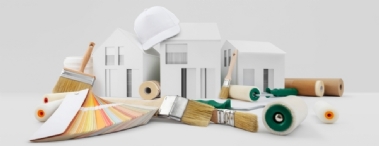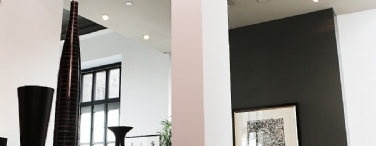
One of the quickest, easiest, and least expensive ways to change the look of a room is to paint. However, not all paints are completely safe, at least not for all people. Before you start choosing your favorite colors, take a moment to learn what you need to know in order to stay safe when you paint.
Lead and Asbestos
Depending on the room you're painting, you may have to scrape old paint or at least sand to give the new paint the ability to stick to the surface. If your house is from the 1970s or older, there's a possibility that toxic substances could be found in the paint.
Don't be fooled by a room that looks like it was painted in the past few years' there could be dangerous layers underneath. Lead is a huge problem and was once used in many types of interior paint. This element is especially dangerous for children, but can harm anyone.
Lead paint was used mostly before 1970s, but still could be found in paint up until 1978. It is harmful, even if the paint is dry and in good condition, and you should take care to not just test the paint, but remove it rather than just paint over it.
Asbestos is just as dangerous, if not more so, than lead. It was once used in most home construction products due to its inexpensive nature, durability, flexibility, and insulating qualities. However, when breathed in or swallowed, this substance can cause cancer, lung problems, and a number of other hard-to-treat medical conditions that are often only diagnosed when they are too late to effectively treat.
Unlike lead, paint that contains asbestos is only dangerous if there is chipping or the asbestos is released with sanding. A professional can tell you whether it is safest to remove the paint or leave it in place and paint over it.
Paint Fumes
Most people are prepared for fumes when painting, but with some paints, the fumes can be very dangerous. In general, the safest paints are those that can be cleaned with water, latex and acrylics. On the other hand, oil-based paints contain more dangerous chemicals to keep them smooth and thin. Not only do they catch fire easily, but they also can cause headache, dizziness, drowsiness, nausea, or coordination problems.
Long-term exposure to these fumes can pose even more potent medial threats, including cancer, brain damage, liver and kidney problems, and more. Along with the fumes associated with paints, be care about the chemicals you're be exposed to when you use paint thinners.
With oil-based paints, you'll need paint thinners to clean your hands and brushes, but the fumes in this case can be just as damaging as fumes from paint in fact, many of the same chemicals are involved. No matter what type of paint and paint thinner you use, make sure that you keep your work area well ventilated.
Read the manufacturer's instructions, and wear a mask if you don't have at least two windows open for ventilation. With paint thinners, make sure you avoid contact with your skin, and wear safety goggles if you're working inside.
Pregnancy and Painting
Exposure to paint fumes and toxins can be dangerous for you and your baby. Water-based products are typically safe, as long at the area is well-ventilated and you don't feel ill. However, oil-based paints can be extremely dangerous, and if you're pregnant, you should make sure the paint is dry and the room airs out before spending any time in it.
In addition, keep in mind that painting can be dangerous for women who are pregnant because of the drop cloths on the floor. You don't want to trip or slip due to the extra piled fabric or plastic everywhere. Also, it goes without saying that pregnant women should avoid painting jobs that require ladders, and if you feel tired, take more breaks than others who are helping with the job.
It's safest for both you and your baby if you just listen to your body. In general, painting is typically very safe. If it wasn't safe, thousands of people wouldn't be painting their rooms every day! It is important for you to read all of the safety instructions found on paint cans, however, and on top of that, you should always talk to your doctor about any health concerns you might have that could be aggravated by painting.
Conclusion
Approach painting in a safe way, and do your homework to find the safest products on the market, and the best to use in your home. With the proper planning and care, painting is not only safe, but also one of the smartest home improvement projects you could do if you want to make a big impact with your room's style.
Posted by: Aunindita





